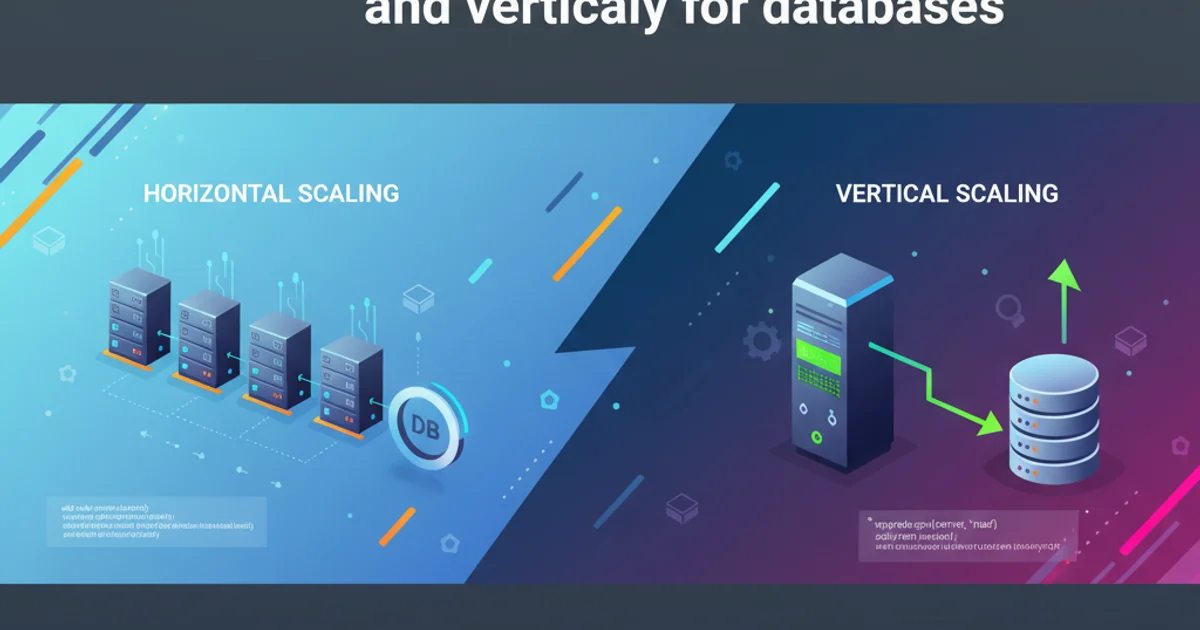Difference between scaling horizontally and vertically for databases
Categories:
Database Scaling: Horizontal vs. Vertical Explained

Explore the fundamental differences between horizontal and vertical scaling for databases, understanding their benefits, drawbacks, and when to apply each strategy for optimal performance and cost efficiency.
As applications grow and user bases expand, the underlying database often becomes a bottleneck. To handle increased load and data volume, databases need to scale. There are two primary strategies for database scaling: vertical scaling (scaling up) and horizontal scaling (scaling out). Understanding the distinctions between these approaches is crucial for designing robust, scalable, and cost-effective database architectures.
Vertical Scaling (Scaling Up)
Vertical scaling, also known as 'scaling up,' involves increasing the resources of a single server. This means upgrading components like the CPU, RAM, or storage capacity of the existing database server. It's often the simplest initial approach to improve performance, as it doesn't require significant changes to the application's architecture or database design.
flowchart TD
A[Initial Database Server] --> B{Upgrade Hardware?}
B -- Yes --> C[More CPU/RAM/Storage]
C --> D[Enhanced Performance]
D --> E[Single Point of Failure]
E --> F[Hardware Limits Reached]
B -- No --> G[Consider Horizontal Scaling]Process of Vertical Scaling
Advantages of Vertical Scaling
- Simplicity: It's generally easier to implement as it involves upgrading existing hardware rather than distributing data or logic across multiple machines.
- Data Consistency: Maintaining data consistency is simpler because all data resides on a single server.
- Lower Latency: Data access often has lower latency due to all operations occurring on one machine.
Disadvantages of Vertical Scaling
- Hardware Limits: There's an upper limit to how much you can upgrade a single server. Eventually, you'll hit a ceiling.
- Cost: High-end servers with top-tier specifications can be extremely expensive.
- Single Point of Failure: If the single, powerful server fails, the entire database becomes unavailable.
- Downtime: Upgrading hardware often requires taking the server offline, leading to application downtime.
Horizontal Scaling (Scaling Out)
Horizontal scaling, or 'scaling out,' involves adding more servers to your database system and distributing the workload and data across them. This can be achieved through techniques like replication, sharding, or clustering. It's a more complex strategy but offers greater flexibility and resilience.
flowchart LR
A[Application] --> B(Load Balancer)
B --> C[Database Server 1]
B --> D[Database Server 2]
B --> E[Database Server N]
C -- Replicates/Shards --> D
D -- Replicates/Shards --> E
subgraph Horizontal Scaling
C
D
E
endConceptual Diagram of Horizontal Scaling
Advantages of Horizontal Scaling
- Near-Limitless Scalability: You can theoretically add an indefinite number of servers to handle increasing load.
- High Availability: By distributing data and workload, the failure of one server doesn't bring down the entire system.
- Cost-Effective: Often, it's more cost-effective to use multiple commodity servers than a single, extremely powerful one.
- No Downtime for Scaling: New servers can often be added without interrupting service.
Disadvantages of Horizontal Scaling
- Complexity: Implementing horizontal scaling (especially sharding) is significantly more complex, requiring changes to application logic and database design.
- Data Consistency Challenges: Maintaining strong data consistency across multiple distributed nodes can be challenging and requires careful design.
- Increased Operational Overhead: Managing a cluster of database servers is more complex than managing a single server.
- Network Latency: Data access might incur higher network latency due to data being spread across different machines.
When to Choose Which Strategy
The choice between vertical and horizontal scaling depends heavily on your specific application's needs, budget, and growth projections.
Start with Vertical Scaling: For many new applications or those with moderate growth, vertical scaling is the simpler and more immediate solution. It allows you to defer the complexity of horizontal scaling until absolutely necessary.
Consider Horizontal Scaling for High Growth/Availability: If your application anticipates massive user growth, requires extremely high availability, or deals with data that can be naturally partitioned (e.g., by user ID, region), horizontal scaling becomes essential.
Hybrid Approaches: It's common to use a hybrid approach, where individual nodes in a horizontally scaled cluster are themselves vertically scaled to optimize their performance.
NoSQL databases are often designed with horizontal scaling in mind, making it easier to distribute data across many nodes. Relational databases (SQL) traditionally favor vertical scaling but have evolved with features like replication, sharding, and clustering to support horizontal scaling as well, albeit with more effort.